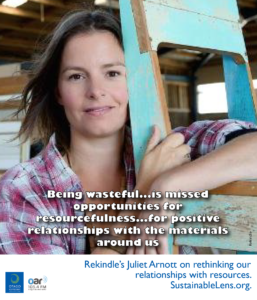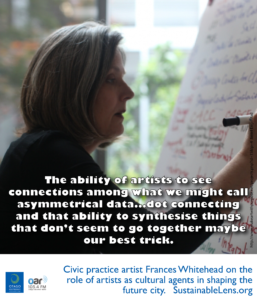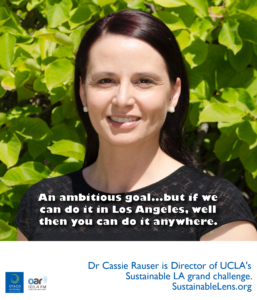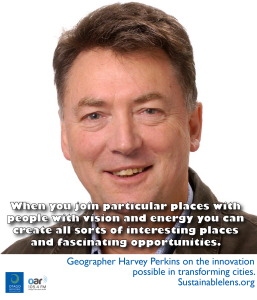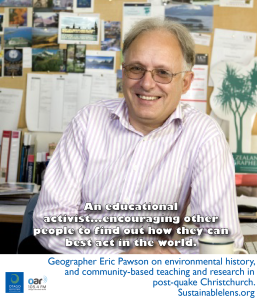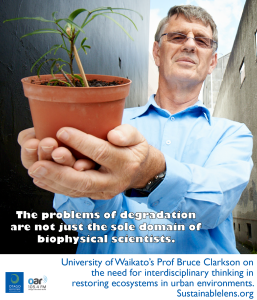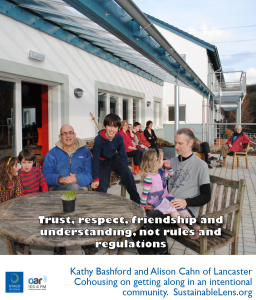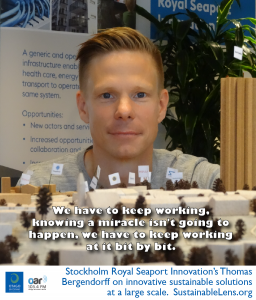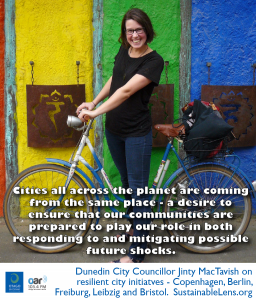| Sam: |
Welcome to “Sustainable Lens, Resilience on Radio,” a weekly show on sustainability topics brought to you by Otago Polytechnic. The show is co-hosted by Shane Gallagher and me, Samuel Mann. Shane’s not here tonight because I’m in Los Angeles at UCLA. Each week we talk with someone making a positive difference and we try to find out what motivates them and what it means to see the world through a sustainable perspective, through their sustainable lens. Tonight’s sustainable lens is that of Dr. Cassie Rauser. She is the director of UCLA’s sustainable LA grand challenge. We’ll find out what that means. Thank you for joining me.
|
| Cassie: |
Thank for being here and thank you for having me.
|
| Sam: |
We’ll come back to this but let’s start with an introduction to what the sustainable LA grand challenge is.
|
| Cassie: |
Sure. Sustainable LA grand challenge is a campus-wide research initiative. It was introduced by the Chancellor in 2013. It’s a little bit different than business as usual, as far as a research initiative goes for a campus because we are organizing the research and the faculty around a major ambitious goal in sustainability. That goal is, or those goals are, to transition Los Angeles the county to 100% renewable energy, 100% locally-sourced water and enhanced ecosystem health and human health and well-being by 2050.
|
|
Instead of everyone continuing to work in their silos on their sustainable and environmental issues, we’re really bringing the faculty together from across disciplines to tackle this major problem and to rally them around these ambitious goals.
|
| Sam: |
I read that part of the goal is to have a thriving in a hotter LA and be a global model for urban sustainability.
|
| Cassie: |
Yes, absolutely. Absolutely.
|
| Sam: |
That’s quite a big call for LA.
|
| Cassie: |
Well, sustainability for LA is a pretty big call, quite honestly. When I heard about the initiative, I wasn’t here at UCLA and I got a phone call and they said, “We think you might be great working on this project. We want to make Los Angeles sustainable.” I kind of laughed and I said, “Yeah, good luck with that.” LA doesn’t have a reputation outside of the LA area as a place that is sustainable. I think that it conjures ideas of smog and urban sprawl and actually a lot of very negative environmental ideas when in fact, LA is really quite fantastic.
|
|
The folks who had come up with the idea of the grand challenge, they were very inspiring, although very ambitious. I kind of started to feel like, “Gosh, if we can do it in Los Angeles, well then you can do it anywhere.” That’s really the idea is like, “Yes, it’s a big challenge here.” We do have a long history of success overcoming environmental challenges. If you were here in the ’70s or ’80s, you couldn’t breathe. You couldn’t go outside I don’t know how many days per year. Obviously, you’re here today, although a little bit cloudy for Los Angeles, it’s pretty lovely and much clearer and the smog has significantly reduced.
|
|
We know that we can pull off things like that so in that spirit, I guess, if we can do it here in Los Angeles, if we can get to 100% renewables, if we can start using the water that we do have here, instead of importing up to 60% of our water from over 200 miles away, as a county, if we can do that kind of stuff here, you can do that anywhere in the world. There are so many major mega cities around the world that can use the technologies, the policies, the management strategies etc., that we will develop and implement here in their own backyard. This wouldn’t just be a success for Los Angeles of course; this will be a success for everyone.
|
| Sam: |
Anywhere in the world. Let’s talk about your anywhere in the world. Where did you grow up?
|
| Cassie: |
North Dakota.
|
| Sam: |
I’ve driven through North Dakota.
|
| Cassie: |
Well that’s incredible. I don’t know many people who’ve been to North Dakota. I usually get the response of, “Oh, you’re the first person I’ve ever met from North Dakota.” Well, in fact, there’s less than half a million people there still so that’s not strange. I grew up in a town of about 40 people, not 40,000, but 40 people and my parents still live in the same house that I grew up in, and everyone around us, they were farmers or worked somehow within the farm industry. We’ve had a sugar beet factory in our town where I went to school.
|
|
In a lot of ways in relation to sustainability I guess, I unknowingly was very much raised in a family that was operating in a sustainable fashion, but maybe for very different motivational reasons or philosophical reasons than kind of how I operate today. You know, not much money, always conserving, always turning the lights off, turning the water off, collecting cans for recycling and making money, but also growing our own food, freezing the food for the winter, bartering … My father was a mechanic and he would fix someone’s tractor and we would get half a pig so I didn’t grow up around fast food.
|
|
I just didn’t have the distractions and some of the negative aspects, I think, that come along with a major city. It’s a very interesting upbringing, but I knew the whole time that I also didn’t want to live in a small town and I felt like there was something bigger and better for me to do. I moved away, I think, literally the day after I graduated high school.
|
| Sam: |
What did you want to be when you grew up?
|
| Cassie: |
I actually always wanted to be a lawyer, and I always wanted to be an activist of some sort. I wanted to be like a social justice lawyer. I went to college in Minnesota, Minneapolis, St. Paul, at a little liberal arts school and that was just such a fantastic, amazing experience for me having come from such a small town. Everyone was really smart and there were so many options as far as careers went that I had no idea about. I quickly realized that I was very much attracted to environmental justice rather than social justice issues, and almost immediately, I became very involved in the Minnesota Public Interest Research Group, the PIRGs, and became active and a leader in that organization. I took a bunch of environmental courses, both on the social and political side, but also started taking them in the science side and realized that, oh gosh, science is really quite easy for me and fun so maybe I should do that. That’s kind of how that all evolved and I always continue to be active in the community movements.
|
|
I can’t tell you how many Earth Days I’ve co-organized or organized wherever I was. They started there in Minnesota. I found my way actually to Arizona State. I transferred there eventually and finished, but similarly, I think I was the first environmental … I can’t even remember what they called me but for their student counselor, their student union group, they had no environmental representation. I went to them and I said, “Well, gosh. You need recycling here, and you need to have an Earth Day event, and you need this and that,” and they were like, “Do you want to do it?” I said, “Sure,” and so they gave me a little bit of money and I think I did their first Earth Day and I helped them start recycling. I keep doing that because then I did that in Costa Rica, too. Like it’s so crazy. Keeps following me around.
|
|
Then from there, I went to graduate school. I figured, well, I had done some research and I enjoyed the research, and I thought, “Well, maybe I can contribute the most through getting my graduate degree. I don’t know what I’ll do with that. Maybe I’ll be a professor,” and wasn’t so sure, but enjoyed the learning and always enjoyed the schooling. I went to graduate school in ecology and evolutionary biology and was very, very fascinated by evolution and evolutionary theory, population genetics, how genes are flowing through systems, how it really in the context of sustainability … I mean anyone who knows anything about conservation … how important it is for those genes to continue to be able to flow so that when we’re … When we’re building cities and we’re building walls and we’re building freeways, we’re cutting off this gene flow and that is really affecting plant/animal populations among other organisms. I don’t know, it’s all kind of always been related and always been there.
|
| Sam: |
You started out with explicitly, if not law, but the social sides of the … Is that thread continuing or did that thread continue through that research or did it become more and more technical?
|
| Cassie: |
Oh, the research was much more … It’s much more technical and in fact, my dissertation wasn’t related to sustainability at all. It was very much evolutionary theory and experimental biology, but underlying knowledge that is extremely beneficial and applicable in everything I do because sometimes getting your PhD is much more about the other skills you learn than the tiny bit of knowledge they you know more than anyone else in the world. Yeah, I wasn’t sure what I wanted to do with that and how to apply it, and I had left many options open. I think I really missed the application maybe, or the activism that was always me and what I had always been doing because those five years of getting a PhD, they were about being in the lab and doing the work, and the other parts kind of dropped off.
|
|
I did have a fellowship to go to the National Institutes of Health to do a postdoc, and I went to Costa Rica for what was supposed to be three months to take a little break before what, to me, started more and more to feel like my jail time at my postdoc position. I went to Costa Rica to surf and to do some yoga and to just kind of relax, and realized I cannot go back in that lab. I don’t belong in a lab. I need to be out here. I need to be doing something else. I need to be making a big difference in the community. I felt suffocated and I called them and I said, “I’m sorry, I can’t come.” I stayed in Costa Rica and surfed and did yoga for a while because I didn’t have a job. Things came together. You think, “Gosh, I’m in Costa Rica. This is like the biodiversity mecca of the world. There must be so many amazing things you can do, but I’m an American in Costa Rica. I can’t legally work in Costa Rica. It’s a very different infrastructure for how science and conservation work, etc.
|
|
I explored things I could do in the community, anywhere from essentially volunteering at a preschool and doing what I could with education, art and science. I looked into other teaching opportunities, both high school and there was like some kind of adult community college-ish things going on, but nothing really formal. I explored a lot of different things and in the end, quite honestly, what happened is that that preschool volunteer experience is the thing that paid off because one of the child’s mother’s dad had a development that he was operating in the small beach town where we lived and he heard about me through her. You heard, “There is a woman who lives in this town who has a PhD in biology and I want her to work for my development,” and I said, “No, I am not working for somebody who builds things.” That is the last thing that my conscience would allow me to do. I was convinced by number of folks to meet with him and I did, and I was actually inspired by his vision.
|
|
The vision really was to build. People were building there anyway, quite honestly, and very irresponsibly. His vision was to build a community and it was a pretty upper-scale type community, but around a nature preserve rather than around a golf course. I thought, “Well, that’s pretty cool.” He had showed me his vision and all of that and what his goals were for it, and he really gave me freedom. I’m not even sure I ever met with him more than two or three times in the couple years I worked there. He just let me do what I wanted and it was really such an amazing experience. The idea was to form a public-private partnership, so a partnership with the equivalent of their national park system, to take some of his land, form this public-private partnership so that we had the expertise and really the legal guidance of their national park system in running a park or preserve, but then he had me obviously representing the private side.
|
|
I had a lot of both organizational experience and research experience, but in the United States. It’s very different having to translate that into the customs and the laws and the regulations of what are going on in a different country. I worked really, really closely and side-by-side with this fantastic woman from their national park group to do this and we developed community programs, education programs, recycling programs … Recycling keeps coming back.
|
| Sam: |
What was in the preserve part of it?
|
| Cassie: |
It was mostly mangrove wetlands. It was a piece of land that was actually in between two estuaries so we were along the beach. There were two estuaries. Actually, a national park on the other side of one of these estuaries was Las Baulas, Parque Nacionalas Baulus, and that’s the large Las Baulas leatherback sea turtle. That’s a very famous national park and you know, of course, the numbers of turtles coming to lay eggs there had been dwindling and it’s really tough. This was a piece of land that was actually adjacent in a roundabout way to that national parks land so it was an addition in a way to existing parkland. It’s mostly, I would say … Well, it’s seasonal dry forest but other than that, I mean that’s it. It’s really mangrove and seasonal dry forest.
|
| Sam: |
There was development of housing?
|
| Cassie: |
It was housing development and the developments prior to me being there had already made a choice that was legal, but perhaps not wise. They built too close to the mangrove and it really had the community fired up, for good reason, and that was a huge struggle. A lot of the struggle that both myself and the woman I worked with from the park service was community engagement in such a way that … We wanted to do good in the community and that maybe sometimes meant making up for building too close to that mangrove on the first try. Nothing else was along the mangrove. That was just the one very first building they built and that is a thorn in their side until the end, quite honestly. I mean I think the wonderful things that came out of it were a lot of great community engagement and community programmes.
|
|
This was a very international town. The town on the beach was international with a lot of expatriates and folks from Europe and Argentina, and United States, Canada, the whole thing, but the surrounding communities were all Costa Rican communities and I would’ve never, on my own, been able to go into the Costa Rican communities and have the experiences and the effect that I had without working with this woman, of course, who is Costa Rican. I actually married a Costa Rican and had a Costa Rican daughter. That helped a little bit, but they were very suspicious of course of the developers, and rightfully so, for the most part.
|
|
I think we had a really lasting impact in bringing good resources and community programs to them. The recycling program which was not started by this group, it was actually started by now my very good friends, Gina and Tony, who live back in Minnesota. They brought me on really early on and we started this recycling program that, to this day, is still happening and I can’t tell you how excited I am. That from once a month, everyone bring us your trash to the beach and we’re going to sort it, and have this guy come in his truck and pick it up and haul it all the way to the capital city like four or five hours away. He sells it. He gets his money, whatever, but we were recycling.
|
|
Then I helped expand that into the Costa Rican communities and they actually very much had a tradition of recycling because they were used to recycling glass bottles. Many of the older generation folks, they were like, “Why these plastic bottles? What can we do with them? They’re just trash and lying around and we can’t burn them.” It’s too bad, you know. That was a lot of obviously American influence that changed the way that they are bottling and receiving their … things are packaged and receiving their food and drink. These programs have continued and the recycling program evolved into something the municipality actually has undertaken, and by the time I had launched Costa Rica, we had begun talks with the municipality to get them on board to pick up recycling the same way that they would pick up trash. I’m actually very impressed that it ever happens. I think there were some great successes and the project actually ran out of money and that’s why I ended up coming back to the United States, but I think some good things did come out of it.
|
| Sam: |
I was about to ask, but I’ll ask anyway if sustainability is the bit at the intersection of the Venn diagram that I don’t like, but let’s stick with it for the moment. Then it is where the environment and society and economics interact. This seems like a good example of something that’s actually operating in that intersection. I was about to say, “Is it working?” Then you said it’s run out of money.
|
| Cassie: |
Well, 2008 happened. I mean the economic crisis happened. They were trying to sell high-end homes. That’s a second home to people who are buying those homes so they weren’t selling, obviously, at the range that they had thought that they would be selling. Well, the environmental girl was the first person to go. To some extent, I was probably sort of a piece of jewelry for them, right?
|
| Sam: |
Mm-hmm (affirmative)
|
| Cassie: |
They let me do what I wanted to do, but I mean the integration with what they were doing was very minimal.
|
| Sam: |
That’s a shame because what I wanted to know is if it is working at that small community level. Is that the model for what has to happen of the whole … over a huge city such as LA?
|
| Cassie: |
Some of the most valuable things I learned there were from the practices of their national park system and the way that they do approach that. They very much approach it like the Venn diagram, although I’ve never seen any of them use the Venn diagram. They really put effort into educating the communities where they have their parks. With the turtle experience … I’m sure many people know this story. One reason there was decline with the turtles, other than a lot of extra homes and lights and things like that and extra infrastructure, was because people would steal and sell and eat the turtle eggs. These people were making a living on doing that and so for the park system to come in and say, “No, these are a protected species. This is protected land. You can no longer come and take these eggs in the middle of the night,” that was really huge for the community.
|
|
The way the park system approaches that is that they retrained these individuals to be like where the park. Sometimes I can’t remember the words in English, you know, like the park rangers. They did workforce development and workforce training, and they gave these individuals other career options where they could make money. That was something they consistently did and was there. They were very conscious of that and it was really such a great execution of the Venn diagram of the sustainability model where they weren’t displacing people.
|
| Sam: |
Then you came back. Did you go straight back to Irvine?
|
| Cassie: |
I did. I came back to Irvine. I felt Irvine was a familiar place after four years of living in a let’s-have-coffee-in-a-hammock-in-the-afternoon kind of lifestyle. I mean it was culture shock to come back to the United States. One I did at Irvine actually was a bit different. I kind of left Costa Rica thinking, “Gosh, if I’m going to go back into academia, I don’t think I want to a researcher. What am I going to do? I feel like I don’t have any skills.” You know, I know how to sex a fly. I know how to sequence DNA. It’s like what are my skills? I felt a little bit lost so I thought maybe nonprofit, I am not sure. Anyway, I found my way back to Irvine and it was in a position that’s called research development. What that means is truly the development of research ideas, the research teams of proposals to fund those ideas and those research teams, so it’s the whole gamut of the research enterprise and I don’t just focus anymore on sustainability issues or even biological issues.
|
|
I was in an office that served all of the sciences, medicine in the stem fields, and the reality is that that type of job utilized all of my organizational skills, all of my community skills, all of my diplomacy skills, all of these skills that being this environmental activist my whole life had given me and I just didn’t realize, gosh, they’re truly applicable in so many ways. It was fantastic to be a part of, in some way, all sorts of kind of science going on. It was never boring. It was always the cutting edge work that was going, and really the focus was to provide support for the faculty and researchers working on interdisciplinary projects which, as you know, it’s not usually within their comfort zone or naturally what occurs in a university.
|
|
I think the trend in funding has really shifted the trend of what’s going on the university. I also think the fresh, younger professors and researchers are also a lot more keen on interdisciplinary work. I think there’s just a big shift happening in that way and it’s pretty exciting because if you take that back to sustainability, no one discipline could ever solve the problem of sustainability, ever. You know, no one technology is the silver bullet. You need to develop that technology. You need to have the policies in place for that technology to be applicable. Applied, legal, you know there are many technologies that we have that can solve so many of our problems and we can’t use them.
|
|
From Irvine, I think as I mentioned before, I got the call from UCLA when they were dreaming up this sustainability project. It was a matter of somebody had met me, knew that I did research and proposal development, also knew I spent time in Costa Rica doing environmental work and activism and this and that, and they thought, “My gosh, we need to combine all of that to have somebody come and lead this program,” and quite honestly, that was a great vision that they had because I think this really is just like the perfect job for me. It’s so amazing. It’s so fun to be a part of. I sometimes miss doing the research, but even in this, I’ve been involved as much as I want to be on that side as well.
|
|
Right when I got here, the first project was truly, “Okay, we need to coordinate and develop a research plan. You know we have these goals, we have this vision but, my gosh, how are we possibly going to get there?” I coordinated and brought together 28 faculty from across campus, so very multidisciplinary, organized them into our three major groups of energy, water, ecosystem health. In that energy room, we had lawyers with engineers with policymakers with urban planners and me, a biologist, and some of those conversations were really hard and when you get people with such different perspectives or different ideas of how the problem should be solved, it can be difficult but when you can get over that hump, it can be incredible and just so rewarding. The ideas that come out of that don’t even compare to what you would get being in the room with just a single type of researcher.
|
| Sam: |
The three goals, renewable energy, locally-sourced water and ecosystem health, which is the hardest one? Which is going to be the hardest one? This is a long-term plan. You said 2050?
|
| Cassie: |
Mm-hmm (affirmative)
|
| Sam: |
You’re going to be here for a while.
|
| Cassie: |
Well, you know. I feel like even if we got 50% of the way there, I feel like it’s still a huge success, right? The hardest … I’ll tell you what. I feel like in energy and water, I think we, even with existing technologies, we can do it. We know it can be done, now can it be done sustainably? Can it be done economically? Can it be done while not imposing hardship on lower-income communities? Can it be done efficiently? Those are all research questions that we need to address in the next five years. With ecosystem health, and that also includes human health and well-being, that one we found was a lot more difficult to, one, define what that meant. You’ll notice it’s the only one that doesn’t have a quantitative goal. It’s not a quantitative goal, I guess, enhanced ecosystem health.
|
|
The one thing I want to point out that was very important to me to do is that the language for that started out as something along the lines of “without harming biodiversity to achieve these other two goals,” and then just kind of, “let’s not mess it up any more than we’ve already messed it up.” I said, “No, that’s not ambitious. That’s not acceptable.” I want it to be better. I want urban ecology to be incredible. I want people to think about it, to notice it, for it to be a part of their lives, you now? We realized through the process that we don’t know much about urban ecology, that we don’t know much about the species that exist here. LA is really fantastic and I think most people don’t know unless you’ve spent some time here that there is a lot of protected land. We have a lot of protected land in LA County and so we do know a lot about what happens in the Santa Monica Mountains, for example, because it’s natural, protected land and people do research there. People don’t do research in the concrete jungle.
|
|
People think there’s nothing going on, but I think there really is. It’s not ideal what’s going on and there are a lot of invasive species that have now … not invasive, sorry … non-native species that have found their home here so we have a lot to think about on what do we do with those? How do we integrate them? Is it okay? Can a hard-core ecologist get over the idea that sometimes the non-native is okay? There are a lot of questions. Then we’re also so incredibly culturally diverse in LA County. I think we are the most diverse area in the world and so, culturally, what does biodiversity mean to all of these different groups? What does a lawn mean to different groups? Is it a status of an economic status? What does the rosebush mean? It takes up a lot of water, but I mean these things mean different things to different cultures and I think we need to be really sensitive about those feelings and how we integrate all of this and still make it better. I think that one’s the most challenging, quite honestly.
|
| Sam: |
The lawn was a good example because as you get closer to UCLA and the houses get bigger, the lawns get bigger and the lawns get greener.
|
| Cassie: |
Oh, they do. It’s no secret. Well, it’s kind of a secret because you can’t, of course, see individual water use but there is, of course, a lot of talk that has been going on with regard to lawns and the use of water and the responsible use of water, and how do we price water so that that type of behavior is deterred in some way? Yeah, definitely the poorest communities already use the least amount of water compared to the wealthier communities. There’s a lot of shaming going on. There’s a cultural shift that needs to happen here, but a lot of great, just personal conservation has already happened. Los Angeles, the state has water-mandated goals right now because of the drought and Los Angeles, I believe, has already met the goals or is only about 1% away from meeting their conservation goals with water. People have stepped up and people are conserving, and it’s going in the right direction. It’s definitely motivated by the drought, which is kind of the only good thing about the drought. Hopefully these are types of behaviors that aren’t so much of an imposition that people will continue.
|
| Sam: |
Tim Flannery, who we talked to a few months ago, said that the current El Niño is a good thing because it’s given people a bit of a view into the future. The drought is perhaps doing the same thing.
|
| Cassie: |
Absolutely. Absolutely.
|
| Sam: |
When it starts raining again, will people forget?
|
| Cassie: |
I think so.
|
| Sam: |
Let’s party in the swimming pool again.
|
| Cassie: |
Yeah, everyone was expecting the El Niño to bring us a bunch of water to LA and it didn’t. Prior to El Niño, the Godzilla El Niño, as it was referred to, everyone was just like, “We’re going to be fine. We’re not going to have to conserve water anymore,” and it didn’t happen. It didn’t happen and so that’s an eye-opener, too, that some of these changes need to be permanent. California is just really incredible as far as being a leader on environmental policies so I think it’ll stick. If the policies stick, then I think we have some hope here.
|
| Sam: |
California might be a leader on environmental policies, but it’s also, as you say, a concrete jungle with cars everywhere.
|
| Cassie: |
There are.
|
| Sam: |
Can a city be sustainable just on those grounds? It doesn’t seem to me that that would be a sustainable model for that. Even if it was all electric powered, it still has to come from somewhere.
|
| Cassie: |
Right, but what if all cars were electrified and all of our electricity came from renewable sources? That’s pretty sustainable. We’re going to have self-driving cars and the car culture is changing in a sense like never before and at a very rapid rate. We have shared transportation. We don’t just have public transportation anymore. We have Uber and Lyft and what not, and that has really transformed the way LA operates in a huge way. I am personally getting rid of my car. I live in LA. People would’ve thought you were a nut, like, “You can’t do that.” I take public transportation all the time. I have two children and a husband, and we currently have two cars but our lease is up and I’m done. I’m done so we’ll have one car because my husband drives for his job.
|
|
It’s not necessary anymore and I think the younger generations, all the studies show the millennials aren’t getting their driver’s license. The millennials are using shared transportation networks and that works better, too, for low-income neighborhoods, you know, the last mile to get to and from public transportation if that’s the hardship. The Los Angeles Metro did just open the train that goes all the way to the Santa Monica Pier now, so that’s the first time since … I can’t remember, the ’60s or something like that. Now, the train, you can go from Downtown Los Angeles all the way to the beach and prior to that, there was essentially no rail transportation on the west side. The greener the lawn, the less public transportation.
|
| Sam: |
When you’re talking about those energy and water, you said they could be done with existing technologies, but can it be done sustainably? That’s a nice model. I like that. Can it work economically? Can it work in terms of social justice? Is that connection widely felt? Yes, we could solve this technical problem, but that’s not necessarily solving the sustainable approach to it.
|
| Cassie: |
In general, I think so, and I think that’s partially because we have such great leadership in the Los Angeles mayor’s office. They developed and released their first sustainable city plan in 2015, and that plan is truly a sustainability plan. It’s not an environmental plan so I think when people hear the word “sustainability” in general, because very often, the word “sustainability” has been used to mean environmental but it has a negative connotation and that anyone who is against the environmental movement, because it’s not thinking about business, it’s not thinking about these other things, can be turned off by that. Sustainability is gaining traction globally as a concept and idea that truly encompasses the economic and societal parts of that. Like you just said, something isn’t sustainable if you can’t economically do it. I’ve had that conversation, I can’t tell you how many times, where I’ve had to remind somebody like, “No, we’re not just going to make you use that or make that technology be the way to go. It has to work economically.”
|
| Sam: |
What’s your go-to definition of sustainability?
|
| Cassie: |
Oh, that’s a good question. I do often refer to, I guess, what you would see in the Venn diagram, but sustainability in general, of course, is something for us to use today that will not harm future generations or will not leave future generations without resources.
|
| Sam: |
A Brundtland definition…
|
| Cassie: |
Yeah, it really is, but that’s what sustainable means, whether you’re talking about the environment or not.
|
| Sam: |
What do we think that those future generations will be thinking about what people are doing in LA now?
|
| Cassie: |
Well, hopefully they’ll look back on sustainable LA and they’ll think it’s just amazing because we will have been successful. Gosh, that’s a good question. I think I feel like we’re in a really great era right now. I feel very positive and I’ve been working in environmental movements long enough now to now have always felt like I was gaining traction or that I was being heard, but now you have major leaders who truly believe in this and are progressive enough and visionary enough to see that, “Gosh, if we continue what we’re doing, there are no future generations. There’s nothing for them.” Even today, this is about making quality of life better today and I think we can do both. I feel really good about it right now and maybe it’s because I live in the bubble of California, but again, hopefully we can continue to serve as a model.
|
| Sam: |
What’s the coolest thing you’ve done in the last couple of years?
|
| Cassie: |
The coolest thing?
|
| Sam: |
Yeah, a thing you’ve seen that you thought, “That’s awesome,” or either you’ve done or you’ve seen one of your colleagues do and you thought, “That’s something we need to bottle. Let’s do that more.”
|
| Cassie: |
Wow. Well, I had a child in the last three years so I’m going to say that’s the coolest thing I’ve done. I have to say that.
|
| Sam: |
Let’s not bottle a child.
|
| Cassie: |
Let’s not bottle the child, but if we could bottle their energy and their spirit, that would be amazing. Gosh, there are so many things. There are a lot of really cool technologies and I feel like everyone has seen this, but I remember that ah-ha amazing moment when I saw the transparent solar, flexible solar panels. I wouldn’t even call them panels, right? You know, the ability to put solar on windows, the ability to put solar in car paint, the ability to put solar on the streets, this is amazing. This is so incredible. We can constantly be getting energy from the sun that comes up every day. That was pretty incredible.
|
| Sam: |
Do you think we can get there with such technologies, the cool stuff, or are we going to have to consume less?
|
| Cassie: |
Both. It’s absolutely a combination of the two and that’s funny. I think people have a very different perspective in that, in that a lot of individuals believe that we can continue to consume and do what we want because technology is always going to come around at some point and fix this, which is a strange way to not really take responsibility for your own actions or to be a part of the solutions. I always believe in being a part of the solution and that means you recycle the inside part of the toilet paper roll at my house. Every little thing counts.
|
|
I definitely think it’s a combination and in the research plan we developed, that’s really what we came up with, that in order for us to get to local water … We do have quite a bit of rain here in LA, sometimes 12 to 15 inches a year … and that the combination of reduction in consumption and technology combined because with the water, we’re seeing we can already get a huge reduction with just really small behavior changes and so combine that with the technology and yes, that’s how we can get there. Definitely, reduction in consumption needs to happen and we know it can happen and we know we have a lot of room to reduce consumption because if you compare consumption across the world, I mean we have a long way to go. There’s a lot of wiggle room there.
|
|
Similarly with energy, most of the energy accomplishments that we’ve seen to date are because of efficiency measures, so not only just consumer behavior, but retrofitting light bulbs. These were consumer changes in consumer behaviors in many ways. The first time you started using the different light bulbs, you were like, “That light’s kind of funny. I don’t really like it,” but I think people are really used to it now. They’re saving a lot of money, saving a lot of energy, so those little things make a really big difference and they’re not imposing too much upon the individual.
|
| Sam: |
Will those little things add up? Are they enough?
|
| Cassie: |
Oh, they definitely add up. Those little things, water conservation, we’re a perfect example. That has added up in California. We’re reaching the mandates and we’re doing that simply through our actions. Nobody put in a recycling plant since the mandates came down. This is really all human behavior in reduction and consumption.
|
| Sam: |
Is anybody complaining about that? Are people having a lesser life because of it? Part of the opposition to the sustainability movement is, “You’re wanting me to go back into the caves.”
|
| Cassie: |
Right, it’s about the imposition, so it’s about what the individual feels is an imposition. I think with the combination of technology and slight modifications in behavior, that’s where we come to that equilibrium because if you think of the car and you think of even 10 years ago, who would be driving an electric car, someone who like a Charger or a Mustang probably wasn’t going to be driving an electric car, but now there’s the Tesla and it’s sexy and it’s cool and it’s fast. Now you have a different demographic that would drive an electric car that wouldn’t only 5 or 10 years ago. I think together that these things will bring different populations to a point of not feeling like this is such an imposition on them.
|
| Sam: |
We’re writing a book of these conversations, which is going to be called “Tomorrow’s Heroes.” How would you like your sustainable super power to be seen?
|
| Cassie: |
I think I’m an organizer. I think I’m a matchmaker and I am a very empathetic. I think I have this super-power ability, truly, to understand the different languages that the folks in the different disciplines are speaking, and translating it enough so that they start to understand what the others are doing and what the contributions are realize that they have so much more in common than not. I do often say, because I am always bringing together different groups of researchers and I’m always saying like, “Gosh, I always feel like I’m a translator. It’s so funny and in so many meetings, I will say exactly this, “I think what he’s trying to say is this,” “I think what she’s trying to say is actually this,” and “that you guys are saying the same thing, just from a different perspective.” These folks have gone on to work together, to write grants together, to do projects together, and it would’ve never happened without my super power.
|
| Sam: |
I think you’ve already said that you’ve bridged the qualitative and quantitative, but have you managed to bridge the reductionist and systems thinking people?
|
| Cassie: |
Yeah, a little bit. I definitely am working with those two types of groups. I have had them work together. I brought them in a room together. I do a lot of counseling before and after, truly, but we have some really great visionary system thinkers and they know that they don’t know the tiny details about how the solar is captured and how that’s delivered and how much … They know they don’t know that, but they really are the big system thinkers that we need to kind of help pull this all together. I’ve gotten that group to meet with engineers in water and energy, and it’s tough but they’re working together now because they’re giving them the numbers they need to do the big system calculations. This is one of our first projects that we really hope to have done and released, and I think it will be really provocative and incredible because it’ a “What does LA 2050 look like?” Project. It is a big system thinking project, but it really needed all of the reductionist-type research contributions to make it successful.
|
| Sam: |
Are you funding spaces for the creative people to contribute to those?
|
| Cassie: |
Yes, absolutely. Absolutely. That group is actually led by a world-famous architect who is very creative and their visuals are really what drew us to them because they have just amazing ability to create visuals of a city and to the urban fabric and all of that. Additionally, we have other creatives. We are UCLA. We’re in Los Angeles. We have a fantastic film theater television department. We have a great humanities department with an environmental humanities component, and I just met another professor last week who was super interested in being involved and she’s in the arts. They’ve become integrated in different ways. We had a woman in humanities who was fascinated with the idea of trash and has done projects with students on trash and waste, and what does that mean, again, across cultures? Yeah, so this really is interdisciplinary and this can’t be successful without the contribution from all of them.
|
| Sam: |
What’s the biggest success you’ve had in the last couple of years?
|
| Cassie: |
I think the release of our research work plan. That was really a year in the making and what I think makes it so successful was the ability to bring together the interdisciplinary groups and really develop a solid comprehensive research plan. This is the research we think, across disciplines, needs to be done in the next five years to answer the questions that we’re still not so sure about so that by 2020, we can develop a blueprint or an implementation plan for how the transition would actually happened by 2050. We’re a research university and so we do research well and will stick to doing the research, and we understand that we can’t do this alone and this is so much dependent on partnerships; partnerships with the city, partnerships with the utilities, with other institutions, with civil society, with NGOs, nonprofits. I mean you name it. We have to partner and we’re building those various relationships as we’re doing the research and together. We really want to develop an implementation plan that has input from all of these stakeholders.
|
| Sam: |
Do you consider yourself to be an activist?
|
| Cassie: |
Absolutely, every day, all day long.
|
| Sam: |
At work?
|
| Cassie: |
At work, at home, yeah, absolutely.
|
| Sam: |
What motivates you?
|
| Cassie: |
I think what motivates me most is contributing to positive change in the world. I’m a sucker for humanity.
|
| Sam: |
What challenges are you looking forward to in the next couple of years?
|
| Cassie: |
The challenges of figuring out how you get this fantastic research translated into something that is applicable and implementable, if that’s a word, because that is the struggle. There are so many amazing ideas bouncing around this campus, on any campus, and the percentage of those ideas that actually get translated and applied are very small. We realize that that is probably the biggest challenge for us.
|
| Sam: |
Speaking in UC Irvine terms, because I don’t know the people here, do you have somebody like Irvine’s Peter Bowler that is going to go out and say, “I’m going to take this neglected area and regenerate it and actually do this work?”
|
| Cassie: |
Oh, definitely. There are very different degrees of folks in all of the disciplines who are doing very applied work. It’s by far not the majority, but there are definitely your Peter Bowlers here and there are your Peter Bowlers in engineering, too, and there are your Peter Bowlers in law and policy. I have a much better understanding of law and policy, researchers and faculty than ever before. I always was working in the sciences, in the hard natural sciences, physical sciences, and quite honestly, what they’re doing is applied work every single day. That’s the applied work. Now, you can do policy research and then you can write your report and it never makes it into the hands of policymakers, but that’s easy to change. It’s easy to give a report to someone. It’s much more difficult to go out and change the swamp into productive land for a native species like Peter does.
|
| Sam: |
If you could wave a magic wand and have a miracle occur, what would you like to have happen?
|
| Cassie: |
Oh, wow. I think what I would like to have happen the most is equity. I would like to see equity and somebody had brought up the other day in a conference I was at, equality is not the same thing as equity, and that is very much true. With regard to energy, with regard to water, with regard to our health and with regard to our ability to enjoy our ecosystem and receive all of the benefits that this has to offer, I really, at the heart of this, I want to see equity. I want everybody to have that same experience and those same options.
|
| Sam: |
What’s the smallest thing that we could that would have the biggest impact in getting us there?
|
| Cassie: |
That’s a tough one. I think little things make a difference. I think that, quite honestly, if everyone could think of 5 little things they could do in their life, in their daily routine that didn’t, I don’t think, impose on you too much. It’s very slight modifications. If everybody did those 5 little things, that would have a huge impact. We have 10 million people in LA County. If you had 10 million people taking 1 gallon bucket of water from their shower they ran, that’s a lot of water, right. That’s just one little thing so I think it’s the little things. I think everybody engaged in doing some of the little things, that that’s going to make the biggest cumulative impact.
|
| Sam: |
Lastly, do you have any advice for our listeners?
|
| Cassie: |
Advice? Well, if you love sustainability or you love breathing clean air or living in a world that has equity, equality and economic prosperity, then I think everyone can be an activist in a little way. Don’t be discouraged, and that sustainability, as an area, is so broad and so diverse that I think everyone can play an important and interesting role, regardless of what your passion is so take your passion and then you can use your passion for improving life on Earth as we know it.
|
| Sam: |
Thank you very much for joining me.
|
| Cassie: |
Thank you so much. This was fun.
|
| Sam: |
You’ve been listening to “Sustainable Lens, Resilience on Radio,” a weekly show on sustainability topics brought to you by Otago Polytechnic. The show is co-hosted by Shane Gallagher and me, Samuel Mann. We’re broadcast on Otago Access Radio, OAR.ORG.NZ and podcast on sustainablelens.org. On sustainablelens.org, we’re building up a searchable archive of conversations of people from many different fields who are applying their skills to a sustainable future. In our conversations, we try to find out what motivates them, what it means to see the world through a sustainable perspective, through their sustainable lens. Tonight, the sustainable lens was that of Dr Cassie Rauser, who is director of UCLA’s Sustainable LA grand challenge, and a grand challenge it is. You can follow the links on Sustainable Lens to find us on Facebook, and you can listen to us via iTunes and other places for free. That was “Sustainable Lens,” I’m Samuel Mann. I hope you enjoyed the show.
|

